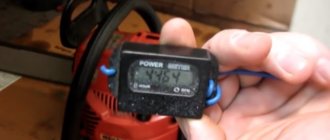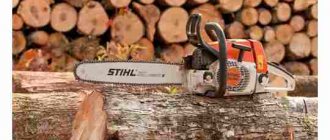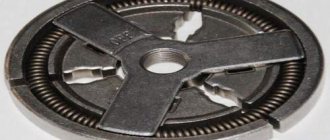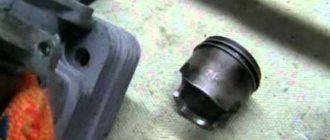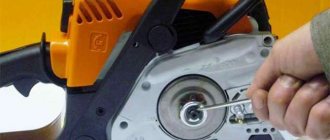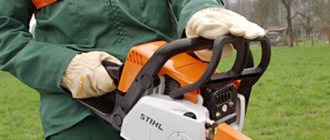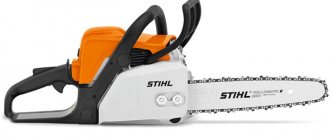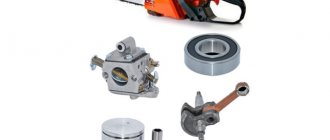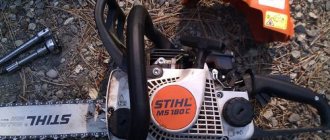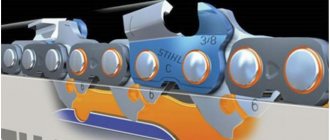Why does a chainsaw stall when you press the gas?
Let's say the chainsaw operates normally at idle, but when you press the gas sharply it stalls. What could be the reason? It is immediately clear that the issue is not the ignition (lack of spark), because if the ignition was faulty and there was no spark, the tool simply would not start. This means the fuel system remains.
There are a lot of malfunctions in the fuel system, and to determine the exact reason why the Stihl 180 chainsaw stalls when you press the gas, it is necessary to carry out a complete diagnosis of it. We recommend reading about common malfunctions of the Shtil 180 chainsaw and their elimination.
Filter check
The first thing you need to check is the fuel filter.
In some cases, a filter clogged with dirt is unable to pass through the fuel mixture in sufficient quantities. Accordingly, there is a shortage of fuel in the system, which leads to the fact that when you press the gas of the chainsaw, the fuel burns out, and new fuel does not yet have time to arrive, as a result of which the Shtil chainsaw stalls. Also, if the fuel filter is clogged, there may be a noticeable drop in the power of the chainsaw at maximum speed, but this is with minor contamination.
Air filter
On the pages of the World Wide Web, you can find information that the Shtil 180 chainsaw may stall due to severe contamination of the air filter. I would like to refute this not entirely correct information and report that the Shtil MC 180 carburetor is equipped with a compensator, which is designed and installed in order to take in the air necessary for the normal operation of the Shtil 180 chainsaw, bypassing the dirty air filter. Of course, the power with a clogged air filter will drop slightly, but it definitely won’t stall. The power may also drop due to piston wear, which will require repair of the Stihl MS 180 piston chainsaw.
Carburetor
One of the reasons why a chainsaw does not develop speed when you press the gas, but rather stalls, is a malfunction of the carburetor. Let’s say the Shtil 180 saw worked properly, and then it was installed for a long time and was not used. Afterwards it was started, and at idle it works well, but when you press the gas it can stall. Why does it stall? The reason is a stuck carburetor valve nozzle. Of course, this is not 100%, but the probability of such a malfunction is high. We recommend reading the article about the design and repair of the Shtil 180 carburetor.
In order to check the nozzle, you need to remove the carburetor and disassemble it. To remove, you need to unscrew the two nuts securing the air filter and the carburetor, then remove the air filter and the engine control lever, while disconnecting the air damper control rod from the carburetor. Next, you need to slightly pull the carburetor towards you and disconnect the fuel supply hose.
You need to remove the fuel hose as carefully as possible and prepare a plug for it in advance, since fuel should come out of it.
After removing the carburetor, you need to blow it out and clean it of dirt, only after that the carburetor can be untwisted.
It is necessary to unscrew the cover of the main chamber of the carburetor; this is the one on which the compensator is installed on top. Next, use an 8 mm bolt and a length of at least 50 mm. We knock out the valve.
It is necessary to knock out the valve by placing the carburetor on a wooden stand, this will protect it from damage to the body.
After the nozzle is removed, you can blow it out using a compressor. The valve should only allow air to flow in one direction; if the valve can be freely blown in both directions, it means it is faulty and needs to be replaced with a new one. Reassembling the chainsaw after the valve has been repaired must be carried out in the reverse order of disassembly.
You can see clearly how a carburetor is repaired, or rather, how to correctly knock out the injector valve from the carburetor body by watching the video.
Another common reason why a saw may stall when the speed increases is air leaking into the carburetor. This can only be checked with a special tool, but it is worth noting that if preventive work has not been carried out on the carburetor for a long time, then you can install a new set of gaskets in the carburetor. In some cases, this helps solve the problem of its depressurization.
When disassembling the carburetor to replace the gaskets, you need to carefully inspect its needle valve, press the rocker arm and check its lifting. Sometimes, especially after the Stihl chainsaw has stood for a long time with fuel in the carburetor, the needle may burn to the carburetor body and not perform its functions. Simply put, the needle valve will not allow the fuel mixture to pass through. In this case, the saw will not work.
Saw Shtil 180 Stalls After Heating
Why does the gas saw go out when I press on the gas: reasons and solutions
Often, chainsaw owners have to deal with their breakdown, and it does not matter what model of this type of equipment, since the nature of the failures is almost the same for all. Well, the chainsaw has stalled, so what next? Of course, you can include the equipment in specialized services that will repair your “iron friend” for a fee. But, as they say: why pay more?
In the end, you can personally disassemble the tool and repair it as the breakdown may be minor and you will have to pay a lot for this. But of course, in order to bring the tool back to life, you must be able to understand the reasons for its failure and how to fix it. So let's learn! In this article you can find answers to questions about situations when the tool simply throws after directly touching the gas. So let's get started.
Content
Basic elements of a chainsaw
Before we get into the breakdown issues and repair tools, let's first figure out where the chain came from. , I would like to point out that this tool belongs to the category of equipment whose operation directly depends directly on the internal combustion engine.
It is also important that chainsaws are equipped with a single cylinder engine , and whose operation is carried out on a fuel such as gasoline. It is worth noting that, despite its similarity with other tools, it does not have a gearbox. And it is replaced by a kind of single-stage chain gearbox, through which the chain (saw) itself moves.
In fact, the chainsaw is a fairly simple design, but this does not prevent it from being reliable, practical and fully capable of providing immediate continuous and cyclic work even in quite difficult conditions. This tool consists of a huge range of certain elements “vital” for proper and productive work. This carburetor, a device for direct chain tension, a tire equipped with a chain and other elements.
Before purchasing a chainsaw, be sure to explore all of your options and choose the right chainsaw brand.
To make your choice easier, we have made a chainsaw rating for reliability.
If you have a limited budget, read the article about Russian chainsaw manufacturers.
Characteristic and possible reasons for failure. Fix the problem yourself
Chainsaws. Quite reliable and simple design. Therefore, if you take proper care of them and deal with them based on the manufacturer's recommendations, then they fail, very rarely, and quite quickly, various types of failures are resolved. But if you are faced with such a situation and want to repair your instrument yourself without turning to professionals, read the information provided below.
READ Operation of Chainsaw Shtil 180 Video
In fact, it is impossible to definitively and accurately determine the reason why the tool does not start or stall when you press the gas, as many factors influence it. But do not forget that since the chainsaw is equipped with a simple two-stroke engine, conditions such as lubrication, fuel, spark and air are important for its effective operation.
Cylinder fuel tank
Therefore, the carburetor is directly involved in preparing the fuel-air mixture, the filter cleans the air of dust, the ignition and spark plug create a spark, and lubrication. in gasoline.
Therefore, it is necessary to look for the causes of this type of breakdown in a sequential order, starting with simple ones and gradually moving to complex ones. And this is an important factor in proper repair, since a person who, without taking this into account, begins to analyze the carburetor is putting it at risk. Since this type of device must be repaired or adjusted directly in special workshops (read about setting up the carburetor).
- It is important that for trouble-free operation of the device it is necessary to directly process the fuel . Because if such a mixture is not prepared correctly, most chainsaws simply will not start. Consequently, not every owner will guess the reason for the fuel failure. Therefore, to ensure that your tool always works correctly, you need to use only high-quality gasoline for the mixture.
The saw stalls after short-term operation
After
warming up, does not idle, does not work correctly,
stalls,
scuffs in the piston.
Shtil 230 stalls after short-term operation
The piston does not fit the cylinder.
And just use the oil that is made by your tool manufacturer. In addition, it is important to prepare this type of mixture in an amount that you will use within one or two weeks, but no more (see the proportion of gasoline and oil for chainsaws).
Because otherwise, excess mixture directly in the canister will cause it to lose all its octane properties, and this will lead to significant problems with the tool.
- In addition, the cause of the violation may be direct filling of the spark plug mixture during operation of the mechanism . To solve this problem, you need to unscrew and dry the candle, but remember that it cannot be burned in any way. Excess fuel should be drained through the hole (plug), wait 20-30 minutes, then replace it and try again to start the tool.
- Chainsaws stop when you press the gas because there is no spark . This can happen if there is not good contact between the tip and the (high voltage) wire. However, if such a connection works correctly, but the spark still does not exist, then that is the whole reason. This is the ignition unit (electronic). It is important to note that such spare parts cannot be repaired, so they can be replaced. Checking the spark plug
- If the chainsaw stops when gas is added, it means that there is not enough fuel supplied to fully operate the chainsaw . This may be caused by clogging of the carburetor (its jet) and contamination of the filter itself (fuel). Remember that the first node should only be checked by professionals, but you can clean the second one.
- In addition, the filter (air) can cause breakdown if it is contaminated with dust . But do not forget that each model has its own easily eliminated and characteristic features. It is for this reason that do not hastily start disassembling and repairing the instrument, but it is best to “walk” through forums, where a large number of links are given by different owners, so as not to worsen the situation.
- Here's another reason why the chainsaw nods when you press the gas. muffler _ It is this part that can interfere with the full operation of the tool in cases where it is directly contaminated with exhaust resinous sediments. To do this, you just need to clean it.
- Quite often the partner of the chain saw is pressed, and the reason for this is the piston cylinder group . Because by examining them, namely the piston and cylinder, it is easy to determine the cause of the tool malfunction by directly replacing it. You can also directly drill the cylinder itself to match the dimensions of the new piston. pistol pistol
- Many people ask themselves: why does the chainsaw fall when I press the gas? The answer can also be found in insufficient chain lubrication (see chainsaw oil), as the oil line may be leaking, or the straight channels may simply be clogged. This is why pay attention to the chain, because if it is dry, do not delay cleaning the channels that are involved in supplying oil directly to the tool bar. After this, carefully check the parts where the oil pump connections are connected to the pipes. But if you notice that oil is leaking in the joints or cracks are found on the pipes themselves, then in the first case, seal the leakage points with sealant, and the pipes must be replaced.
READ Chainsaw Shtil 362 Difference From Fake
Do not forget that by examining the spark plug, you can obtain important information about the breakdown of the chainsaw. Because if its surface is dry, then the reason for this is the cylinder, which does not directly supply fuel. This is why you must test the full range of your ideas step by step. If the plug is in black carbon, it means that the carburetor is not working properly, that is, it is delivering too much fuel or pouring oil directly into the gasoline.
Like, for example, a chainsaw calms down when you press the gas for a simple reason, namely a simple blockage of the direct breather.
To solve this problem, all you need to do is remove the (fuel) hose from the carburetor and pay attention to whether fuel is leaking out of it. Because if the mixture flows with a full stream, this means that the partition is not dirty, but if it is the other way around. reason for the breakdown.
But if after inspection you find that there is no damage on the piston and cylinder, in this case the cause may lie directly in the rings (piston). This type of inspection involves inserting the piston into the cylinder and carefully seating it with the connecting rod. If you suddenly feel play, then the rings need to be replaced, as they are already worn out.
READ How to Adjust the Carburetor on a Husqvarna Trimmer Video
Additional Tips
The first thing you should remember when purchasing such a tool. this is that some parts of the saw are new after the end of their service life (passport). It is for this reason that the instructions should always be at hand, as they are described in detail here.
These parts include: a sprocket (drive), a tire, a part of the system (anti-vibration), and a chain . Because we must not forget that if this "filling" is not changed to a new one at the right time, then these worn parts will negatively affect the rest of the chainsaw. It is for this reason that you often check the depth of immediate tooth development. Remember that it should not be higher than 0.5 mm.
To sum it up.
Of course, every thing we bought has an expiration date and sooner or later it breaks and how it becomes offensive is when the extent of its destruction is so great that it cannot be repaired. But you will agree that often we simply neglect technology, and when it stops working, we try to find ways to fix the failures by turning to a huge number of services.
But remember that even if the technology breaks down, we can extend our “life” . All that is needed. it's just about keeping an eye on it and keeping your spare parts clean and organized. And then, undoubtedly, it will last for many more years. Equally important is the use of exclusively high-quality spare parts and “additives” (see Chainsaw injectors). Then your equipment will work smoothly, and you will simply forget what repairs are.
We also recommend that you check out the Stil ms 180 chainsaw.
Why does it stall at idle?
The first and most common cause of this malfunction is incorrect carburetor adjustment. You can adjust the idle speed yourself; for this you need to have a Stihl adjusting screwdriver, which is supplied with the unit. The adjustment hole is located on the right side of the Shtil 180 saw on the handle and is indicated by the symbols “-” and “+”.
If the Stihl chainsaw does not maintain speed and stalls at idle, you can be almost 90% sure that it has a malfunction in the fuel pump operating system, as a rule, this is air leaking into the crankcase through the pan gasket, or, more often, through the oil seals crankshaft. Air leakage reduces or completely stops the impulse, which is supplied through special channels to the fuel pump of the chainsaw. As a result of this, the Stihl 180 chainsaw does not receive the required amount of fuel and stalls at idle.
Diagnostics can be carried out using a special device called a vacuum gauge.
The second way to check the performance of the oil seals is to pour gasoline into the engine crankcase and look at them; if the oil seals leak gasoline, it means they cannot provide normal pressure in the crankcase, which will make idling impossible. And when operating at high speeds, with leaky oil seals, there is a possibility of the crankshaft bearings jamming.
The algorithm for checking the Shtil 180 crankcase and seals for leaks is as follows:
- The top cover is removed.
- The air filter housing and carburetor are dismantled.
- The chainsaw handle is removed.
- The starter spins up and retracts.
- On the side opposite the starter, the side cover and drive sprocket are removed.
- A piston stopper is installed in the spark plug hole or a string from an old starter with knots tied on it is stuffed into the cylinder.
- The flywheel and clutch are unscrewed, after which the parts are removed. It is worth knowing that the chainsaw clutch has a left-hand thread and unscrews clockwise.
- The oil pump drive gear is removed.
What to do
The power tool is operated according to the manufacturer's instructions. Only after checking the chain tension does the unit start. At the same time, the filling of the tanks with combustible mixture and oil is controlled, and the device is securely fixed in the hands. If, after following all the rules, the mechanism refuses to work, then the Shtil chainsaw is repaired.
How to start a Shtil chainsaw correctly: instructions
The tool manufacturer has taken every precaution and developed a manual that makes it easy to start the mechanism. The user will protect himself from injury if he follows the suggested frequency of actions:
- The ignition is turned on and the engine handle is placed in the down position. The flow of atmosphere from the air filter is blocked by the carburetor damper. To properly start a chainsaw, the throttle membrane must be open to enrich the combustible mixture.
- The lever is set to the start gas position. The starter jerks several times before the first spark appears. If the flash passes, the instrument is ready to start. The mechanism operates at high speeds due to the closed throttle membrane. To transfer it to the idle speed regulation, the throttle trigger is pressed and immediately released. The number of revolutions quickly returns to normal.
- The standard Shtil MS unit does not provide additional devices to start the chainsaw in the lightweight version.
Idle speed adjustment
Before setting up, carry out maintenance of the tool. To ensure that the idle speed adjustment is effective, preventive measures are taken:
- carburetor cleaning;
- engine flushing;
- cleaning the air filter;
- warming up the engine.
To adjust the operation of the mechanism at idle speed, use the appropriate adjusting screw. Its rotation depends on the required setting:
- During standard adjustment, the screw is turned counterclockwise until it turns tightly. After this, make 2 circles in the direction of the arrow.
- If the saw operates at low speeds, then turn the screw clockwise until the chain begins to move. Then make half a circle in the opposite direction.
- At high frequencies, the regulator is turned counterclockwise until the circuit stops. After this, the rotation is continued another half turn in the same direction.
It will not be possible to adjust the idle speed if there is air leakage into the engine through the gasket, acceleration pump, seals, or for another reason.
Ignition settings
Gasoline engines are equipped with an ignition system that ignites the fuel. The timing of the flash affects the operation of the motor. During mass production in factory conditions, the ignition of the chainsaw is not adjusted. Marks are placed on the corresponding rotating elements, which are aligned during adjustment. Incorrect adjustment leads to the mechanism starting and stalling.
Before adjustment, check the dryness of the spark plug and the functionality of the ignition circuit. The voltage supply cable to the spark plug is brought to the cylinder with a small gap and the starter is started. If there is no flash, test the cable with a probe. Then check the serviceability of the wire to the shutdown button.
If the cables are not damaged, then check the ignition coil. This is done with a special tester to ring the device. In this case, the indicators on the device must coincide with the technical characteristics of the coil, which are specified in the instructions for use. If inconsistencies are detected, the ignition unit is replaced with a functional device.
The video shows how to quickly set the gap between the ignition coil and the magnet, using a piece of plastic cut from a bottle as a feeler gauge. You can also use an A4 sheet folded into four or a piece of cardboard from a cigarette pack.
The reel can become unusable due to vibration when the tool is dropped or hit, so you need to work carefully.
Why does it stall at full speed?
Very often you can hear the question why a chainsaw stalls at full speed. There may be several reasons. First, you need to consider exactly how the saw stalled. Let's say the tool was working normally and suddenly, for no apparent reason, it suddenly stalled and the starter does not turn over. In such a situation, you can be 100% sure that the chainsaw is jammed and you need to start overhauling it.
The second situation is when the Shtil 180 chainsaw worked normally, then gradually lost power in a short time and stalled, and the cylinder overheated. In this case, the most likely reason is air leakage under the rubber pipe connecting the carburetor to the cylinder or its rupture. The mixture became lean, resulting in overheating. The cause can be eliminated by changing the pipe.
Shtil saw winding device
Those owners of chainsaws who just received a new tool in the morning, unpacked it and assembled it in accordance with the instructions, but were unable to start it or the engine starts and immediately stalls, are especially distressed. Let us warn you right away - under no circumstances try to disassemble the new engine and do not tear off the warranty stickers. Under such circumstances, it is best to exchange the faulty chainsaw for another, or request warranty repairs.
Standard chainsaw equipment
In accordance with the legislation of most CIS countries (including Russia and Ukraine), electric and chainsaws are subject to return if faults are discovered that were not specified by the seller.
The buyer may also demand a reduction in the price of the defective product, reimbursement of the costs of its repair, or a refund for the defective instrument. The owner of the chainsaw can make these demands only during the warranty period, subject to compliance with all the conditions specified in the warranty card. As a rule, the buyer is given 14 days to identify all faults and shortcomings and contact the seller.
We remove the cup, put the key on the hexagon of the coupling and use the hook to unhook the stretched spring.
We immediately put a new one in its place - it’s simple. We hook one hook of the spring with our fingers, and use the hook to pull the second hook into the hole. It will catch, then we push it with a screwdriver so that it fits into the hole properly.
We turn the crankshaft 1/3 of a turn, put the key on the hexagon again, hold it from turning and also replace the spring with a new one. Next - the third. We put the cup in place and work. You can also check the condition of the springs with your fingers.
The stretched spring allows the weights to move on the cross and can be removed very easily. When we replace the springs with new ones, the clutch should become like a monolith and it is not possible to pull the weights off with your fingers, only if you push against it with a screwdriver.
Question: Is it possible to install a Stihl MS 180 chainsaw instead of a standard 30 cm bar, 1.3 tires from 170 by 30 cm, but with a 1.1 groove? What is the threat of such a replacement?
Answer: In my opinion, only unnecessary consumption of chains.
Still, 1.1 has a shorter tooth (and on some models, much shorter), resulting in fewer sharpenings.
The lack of a spark between the electrodes on the spark plug is the main malfunction that creates problems with starting the engine of the Stihl chainsaw. To identify it, you need to unscrew the spark plug and inspect it. If the spark plug is wet, you should proceed to further troubleshooting.
Location of the spark plug in the Shtil 180 chainsaw
To restore the operation of the saw, no matter the Ural or Shtil brand, you need to know the location of the breakdown.
First, we check and change the unsuitable fuel mixture. If the saw still does not start, then we check further point by point.
The problem is in the candle - we pull it out and dry it. Under no circumstances should you pierce it, as this will lead to a malfunction of the part. 30 minutes after drying, you can insert the spark plug back, first checking to see if there is any fuel left in its place.
Almost all tools are organized in the same way, both foreign (Husqvarna, Makita, Shtil, Partner 350) and Chinese chainsaws, as well as domestic ones (Druzhba, Ural). Therefore, finding the reason why the device does not start or stop is not very difficult.
There are four elements where problems may arise:
- The fuel for which the carburetor is responsible;
- Lubrication;
- The air that enters through the air filter;
- A spark, the quality of which depends on the ignition unit.
They all depend on each other and interact with each other. If any element is not working correctly, the saw stops working.
Let's start with the fact that all tools are configured differently. hot and cold. Two commonly used mechanisms are responsible for this process.
Don't forget to look at what the user manual says. It says that when you engage, you need to make sure the emergency stop brake is locked. But starting a saw with a brake is much more difficult, so sometimes it is better not to apply the brake.
As you can see from the manual, there is a fuel tank and engine inside the body, and outside. saw section (bar with chain), handle and starter.
First we need to figure out exactly how the tool is not running. For example, the saw starts, but immediately catches the eye or loses the power of work, the quality cuts.
Possible interruptions occur due to problems in the engine. But I wouldn't recommend taking it apart immediately. It is better to look for the problem using the simplest option.
To restore the operation of the saw, it doesn’t matter the brand Ural or Calm, you need to know the location of the dislocation.
First, we check and change the inappropriate fuel mixture. If the saw still does not start, we check it further.
Currently reading: How to choose a hedge trimmer for your dacha, rating of the best hedge trimmers
The problem is the spark plug. remove and dry. Do not pierce it under any circumstances, as this will cause the part to malfunction. After 30 minutes of drying, you can put the plug back in before checking to see if any fuel is still in place.
The basis of this type of model, as well as all other chainsaws, is the carburetor. But since we are talking today specifically about the Shtil 180 chainsaw, we will not deviate from the topic. So. The carburetor in this model has a single adjustment screw, that is, it is a kind of idle speed adjustment screw. While the jet of the fully loaded load is stationary.
Chainsaw carburetor Stihl 180
In simple terms, we can say that it simply cannot be adjusted (see here), while the full load setting simply cannot be changed. It is important that the carburetor itself was configured at the factory in such a way that, regardless of the conditions under which the chainsaw is directly operated, the air-fuel mixture is supplied to the engine itself.
Let's say the chainsaw operates normally at idle, but when you press the gas sharply it stalls. What could be the reason? It is immediately clear that the issue is not the ignition (lack of spark), because if the ignition was faulty and there was no spark, the tool simply would not start. This means the fuel system remains.
There are a lot of malfunctions in the fuel system, and to determine the exact reason why the Stihl 180 chainsaw stalls when you press the gas, it is necessary to carry out a complete diagnosis of it. We recommend reading about common malfunctions of the Shtil 180 chainsaw and their elimination.
The piston does not fit the cylinder.
Related Posts
The first and most common cause of this malfunction is incorrect carburetor adjustment. You can adjust the idle speed yourself; for this you need to have a Stihl adjusting screwdriver, which is supplied with the unit. The adjustment hole is located on the right side of the Shtil 180 saw on the handle and is indicated by the symbols “-” and “”.
If the Stihl chainsaw does not maintain speed and stalls at idle, you can be almost 90% sure that it has a malfunction in the fuel pump operating system, as a rule, this is air leaking into the crankcase through the pan gasket, or, more often, through the oil seals crankshaft. Air leakage reduces or completely stops the impulse, which is supplied through special channels to the fuel pump of the chainsaw. As a result of this, the Stihl 180 chainsaw does not receive the required amount of fuel and stalls at idle.
Diagnostics can be carried out using a special device called a vacuum gauge.
Very often you can hear the question why a chainsaw stalls at full speed. There may be several reasons. First, you need to consider exactly how the saw stalled. Let's say the tool was working normally and suddenly, for no apparent reason, it suddenly stalled and the starter does not turn over. In such a situation, you can be 100% sure that the chainsaw is jammed and you need to start overhauling it.
The second situation is when the Shtil 180 chainsaw worked normally, then gradually lost power in a short time and stalled, and the cylinder overheated. In this case, the most likely reason is air leakage under the rubber pipe connecting the carburetor to the cylinder or its rupture. The mixture became lean, resulting in overheating. The cause can be eliminated by changing the pipe.
The main reasons for chainsaw failure
Although the chain saw is a simple device, from time to time problems arise in its operation, which can only be eliminated by disassembling it. Examples include the following faults:
- the chainsaw does not gain speed;
- the chainsaw stops functioning when cutting;
- the chainsaw starts and stalls;
- the chainsaw loses its power;
- The chainsaw stalls when pressed.
Most often, malfunctions are associated with interruptions in the functioning of the motor, as well as with malfunctions of other systems and components. Proper handling of this equipment is of great importance. If all the rules of use are followed, problems with a high probability lie in the most obvious ones. When looking for the causes of problems, it is advisable to start by checking the simplest part of the chainsaw and finish with the most complex.
Checking the main chainsaw systems
If the chainsaw refuses to work normally, you need to make sure that all the conditions required for its normal functioning are provided:
Then you need to sequentially check the functioning of all its elements. First you need to check the fuel tank. If the reason is not the volume or quality of the fuel, then the likely cause of the malfunction may be the spark plugs. The spark plug gap should not exceed 0.5 millimeters. If it is too small, this means that carbon deposits have deposited on the candles. In this case, you should remove the spark plugs, clean them, then put them back in place and try to start the chainsaw. In addition, it is advisable to completely replace the spark plugs with new ones from time to time, even if they are in good condition.
Then you need to check the condition of the fuel filter and carburetor. Cleaning the fuel filter yourself is not a difficult task, but carburetor repair is best left to specialists.
The chainsaw starts and stalls - the reason
If the chainsaw starts and stalls during the first attempts to do the job, then the reason may be problems with the chain brake or its jamming due to lack of lubrication. In this case, measure the oil level. If the amount of lubricant is sufficient, then the reason may lie in the tube that leads it to the lubrication mechanism.
Another reason could be a carburetor failure. If it only needs adjustment, you can do it yourself according to the instructions. If the carburetor needs cleaning or repair, then you cannot do without the help of professionals.
Another possible cause of this malfunction is a low fuel level in the tank. In this case, the chain saw stalls when tilted, since the remainder of the fuel mixture ends up in the part of the tank opposite to the place where the suction tube is located.
Why does a chainsaw stall when heating up?
It often happens that the chainsaw starts when cold, but stalls when it warms up. This behavior of the tool can be caused by the following reasons:
- The carburetor is not adjusted correctly. This problem can be identified by how the device starts up when cold. If it is carried out without closing the air damper, and the engine starts without a preliminary flash, this means that after the engine warms up, fuel floods the spark plug. The solution to this problem is to adjust the carburetor. Details about carburetor adjustment
- Malfunction of the coil (ignition module). This problem can be identified by sequentially checking the spark, first on a cold and then on a hot engine. If there is no spark on a hot engine, then you need to replace the ignition coil.
- Spark plug faulty. In this situation, as in the case of a faulty ignition module, the spark disappears when the engine heats up. You need to replace the spark plug with a new one, and if this does not solve the problem, you should check the ignition module and the distance between it and the flywheel.
Why does the Shtil chainsaw not start?
To pre-diagnose the causes, check the operation of the fuel pump, the appearance of the spark plug, the flow of fuel, the functionality of the carburetor and the condition of the filter. Pay attention to the performance of the cylinders, pistons, muffler, and crankshaft bearings. After preventive measures, they try to start the chainsaw. Insufficient lubrication of rubbing parts also becomes a factor in poor performance.
In this article, we will look at the main problems that may arise when starting a Shtil chainsaw (the spark is lost, the tool stalls or does not pick up speed), as well as ways to eliminate them.
No spark
The spark on the spark plug is checked. The functioning of an element is influenced by various factors. When testing the mechanism, the reasons are revealed:
- insufficient carburetor adjustment;
- large oil in gasoline;
- clogged fuel and air filters.
Due to working in such conditions, carbon deposits accumulate on the spark plug contacts. Subsequent corrosion of the conductors becomes the reason that there is no spark in half of the cases of malfunctions. This happens because the gap between the modular contacts changes. To check the spark do the following:
- the tip of the high-voltage cable is removed;
- the candle is unscrewed;
- the tip is put in place;
- the candle is leaned with its wide end against the cylinder;
- start the starter.
If during startup a bright spark resembling lightning appears between the electrodes, then the ignition unit is working. If there is no flash, clean the entire element and adjust the gap between the conductors. Sometimes there is no clearance between the flywheel and the ignition coil. When the flywheel rubs, scratches are visible on its exterior.
Ignition coil malfunction
The module or coil cannot be disassembled; its suitability is difficult to determine without testing devices. Modern ignition systems are durable, lightweight and small in size. They are characterized by almost trouble-free functionality. Problems with a chainsaw malfunctioning due to the ignition coil can be resolved independently.
The outlet wires are tested for damage (including internal damage) that occurs due to vibration leading to friction. If no cracks are detected, then the ignition coil needs to be replaced. Sometimes a module malfunction is indicated by a weak, barely visible flash when the saw heats up. This occurs due to an increase in the temperature of the coil, which leads to an increase in the resistance of the transistor.
The peculiarity is that at the beginning of operation a spark may appear, but after prolonged use it becomes dim and disappears. Modern ignition coils cannot be repaired in a home workshop, so they are replaced with suitable elements.
Fuel supply
After unscrewing the spark plug, a wet coating is found on its surface. This indicates an excessive supply of gasoline to the combustion chamber. For this reason, the tool does not work or stalls, because the fuel does not ignite.
Another inhibitory factor is a clogged breather - a small hole in the gas tank cap. It is cleaned with a needle, otherwise the Stihl MS 180 chainsaw will not start. To determine the incorrect fuel supply, the following steps are carried out:
- remove the candle;
- pour 2 cubes of gasoline into the hole of the candle with a syringe;
- put the ignition device in place and put on the high-voltage wire cap;
- the lever is moved to the hot start position;
- pull the starter handle a couple of times.
If the tool starts and immediately stalls, then the fuel line is tested further. Check the gasoline filter, splashes from the engine crankcase, and the integrity of the partition in the pump when unscrewing the cap.
Crankshaft bearing failure
If the bearings are defective, a slight play is felt. To identify it, the flywheel of the Stihl MS 180 saw is swayed from one side to the other. The movement indicates that the flywheel is being moved towards the electrodes by its own magnets, as a result of which there is no spark. To remove the mechanism, dismantle the cutting element, remove the filter and clutch cover. To lock the crankshaft, remove the recoil starter cover and tighten the two bolts.
The clutch is unscrewed clockwise using the key. Remove the drum with the sprocket, replace the old clutch and tighten it until it stops. The crankshaft is locked so as not to break the starter. The mechanism is assembled in the reverse order. To tighten, the brake handle is tilted forward, the tool is wound in, and then removed from the brake.
Bearings with defects are less often detected (the diameter of the holes in the cage is increased). To determine, disassemble and measure using a micrometer. Broken bearings are indicated by regular knocking noises. In this case, urgent repairs are required, because if the integrity of the crankshaft is damaged, the piston group and cylinder will fail.
Floods the spark plug
In this case, the spark is not able to ignite the fuel, which enters in large quantities into the firebox to burn the combustible mixture. If the spark plug is flooded, then the carburetor is faulty or the cold engine does not start correctly. The engine is purged; the procedure is performed with the ignition off and away from open flames. To ensure fuel ignition at the time of start-up, clean the mechanism:
- unscrew the candle, wipe it dry, let it dry for half an hour;
- a large layer of carbon deposits is removed with a file;
- the gap between the contacts is adjusted;
- turn the tool upside down and drain the gasoline;
- in this position, pull the starter several times (to remove residual fuel);
- Reassemble in reverse order.
Why does a chainsaw stall under load?
Sometimes the chainsaw is unable to function properly under load. Most often this is caused by improper adjustment or leaking carburetor. In addition, the cause of this problem may be air leaks through the carburetor gasket or crankshaft oil seals. A tool that is unable to function under load will also not be able to reliably maintain idle speed.
Diagnostics begins with checking the carburetor and crankcase for leaks. If air leaks through the crankshaft oil seals are detected, they must be replaced. If air leaks are detected in the carburetor, installing a repair kit of gaskets is required to solve the problem.
If these actions do not lead to the desired result and the engine crankcase and carburetor are sealed, then you need to adjust the carburetor.
If a Husqvarna chainsaw stalls under load, then in case of any deviations in the functioning of the motor, you should first of all check the impulse hose, since this is the most common cause of failure of chainsaws of this brand.
